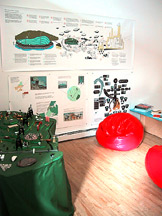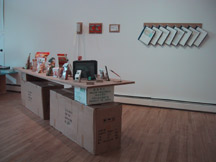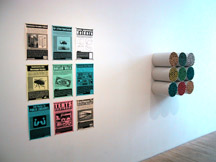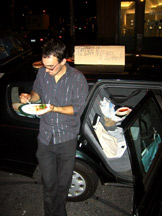"America
is never wholly herself unless she is engaged in high
moral principle... My Friends, we have work to do. There
are
the homeless, lost and roaming. There are the children
who have nothing, no love, no normalcy. There are those
who cannot free themselves of enslavement to whatever-drugs,
welfare and the demoralization that rules the slums...
The old solution, the old way, was to think that public
money alone could end these problems. But we have learned
that this is not so. And in any case, our funds are
low. We have a deficit to bring down. We have more will than
wallet; but will is what we need."
-George Bush, Inaugural Address, Friday, January 20, 1989.
From our current vantage point,
the lack of obfuscation in this speech is notable and one
could hardly imagine a more recent president or press secretary
speak with this amount of candor. Couched in between the
inspirational phrases, the facts are made plain. We aren't
going to spend money on certain social services anymore.
This was the basic truth behind George Bush's poetic call
for the "thousand points of light", a massive
government retreat from social investment dressed up in
a rhetorical appeal to its citizens good nature and initiative
to pick up the slack.
However, those thousand points
of light are not just the heating bulbs at the church bakesale
or the porchlight at the local soup kitchen. Points of
light might also include torches, fuses and bonfires, and
the lack of specificity for just what sort of light was
called for was an interesting slip; for the administration
and the speechwriters and the policy-makers forgot the
simple fact that when one no longer offers something, then
one relinquishes some control.
The Government's retreat from
serving as a partner in social welfare opened up the field
to people with very different ideas about what is worth
doing in the world. Where the government retreats, local,
provisional solutions become manifest through voluntary
association and shared values. You don't have to look farther
for evidence than private initiatives such as the various
cannabis buyers clubs, where low cost marijuana is sold
to those with debilitating illnesses. These efforts to
put a "kinder face" on people's suffering have
been constantly harrassed by the federal government in
the same way as the Sanctuary Movement churches were persecuted
for harboring Latin American political refugees fleeing
tyrannies supported by our national policy. One government's
illegal action is another private citizen's moral obligation.
It is here that the conception
of this exhibition begins, and its underlying idea extends
from the poetic conceit of its title. The shadow cabinet
is an instrument used by parties that are not in power
to model alternatives to the current ruling government.
Though actually powerless, shadow cabinets create a vision
of what might happen if the tables were somehow turned.
They are a glimpse of the might-have-been and the perhaps.
Since shadow cabinets essentially work through the creation
of metaphoric and symbolic alternatives rather than real
political power, they seem an apt location for artistic
overlay and occupation.
While the title extends from
a poetic thought, the idea for the exhibition arises from
an observation of current tendencies in the art worlds.
There has been a distinct rise of artist-initiated projects
which have at their core a structure of dispersal, one
that seeks to connect audiences to useful goods and services.
It is interesting that this has occurred roughly over the
same period of time that our national government has abandoned
somewhat similar projects and responsibilities.
I heard about the artists groups
in this exhibition in a piecemeal fashion, either because
I knew them personally, or had become aware of them from
link sites on the internet and through word of mouth. The
idea for the creation of Shadow Cabinets as a program
came mainly from meeting these groups and listening to
what they were interested in doing and finding out what
they had done in the past. Such projects as Nuts Society's Writing
Thai-A Learning Reform (in which they created and taught
a new associative vocabulary for learning the Thai language
based around words with democratic values and social meaning)
spoke very clearly of personal, slightly quirky initiatives
that sought to create highly local and accessible versions
of the civil services. What the groups had in common was
a sense of personal commitment and a desire to make art
in the public sphere that was not circumscribed as "public
art".
I have instead asked the artists
to present their own descriptions of the projects they
are undertaking for the Shadow Cabinets exhibition.
These statements are printed in this brochure and contain
not just plans for action but the backbone of those decisions
as well. It is worth remembering that artists' are not
always precise public activists and are generally not seeking
to become full time social workers; their engagements wander
more towards the symbolic and the fugitive. It is probably
not coincidental that the physical forms for their projects
borrow from existing government structures and materials.
There are echoes of educational planning, census forms,
government pamphlets, public hearings, even the stickers
one receives after voting. Taken together, they create
a divergent vision of what governments by the people might
be.
But as much as their projects
draw upon governments for their visual form and institutional
structure, their movement and the undertakings of the work
have more in common with the structure of voluntary associations.
The dialogue occurs between individuals and exchanges happen
locally. At a larger level, it is here that these projects
speak about more than just political and social ideas,
and have implications beyond that of shadow cabinets and
alternative governments. They also become examples for
the larger idea of art in the world.
The idea of art in the world
has been with me for sometime, but throughout the planning
of this exhibition, I have been dwelling on it. And yet
I am still not sure exactly what it is. The phrase arose
out of observation and dialogue, rather than art magazines.
If there is such a thing as art in the world, it would
certainly trace its parentage back the experiments in performance
and conceptual art that sought to create an art-life fusion.
Yet it separates from these prior movements by not being
interested in the "blurring" of the two worlds
as an endpoint or a priority. These projects in the exhibition
do not hide the fact that they are conceived as art, nor
do they attempt to blend in with daily life, only known
as artworks by those "in the loop". They want
to connect to people, to offer them goods, services, information,
a leg up or a helping hand, and they want to do this in
the world where people live as well as in the galleries
they visit.
At the time of this writing,
the projects are only just beginning. They will unfold
as the exhibition does, actively, through public engagements
and shared ideas, as well as through exercise classes,
free food in SoHo and a public symposium on New York's
garbage policy. Our challenge is to engage with them as
fellow citizens rather than gallery viewers, to risk involvement
through participation, assistance and debate.
Ted Purves
©2002
Ted Purves is an Independent Curator and
Visiting Professor of Fine Arts at JFK University, Oakland,
CA
Statements from the artist
collaboratives:
Nuts Society
Communicating and connecting new thinking to the society/world are some of
Nuts Society goals. Writing Thai : A Learning Reform project is
another such art concept/project that attempts to facilitate/cultivate
good values and morals through a new learning activity. A basic and traditional
Thai alphabet exercise book has been readapted into two formats (poster
and instructional cd-rom). The various letters of the Thai alphabet are
each linked to specific words, with the underlying intent of creating lifelong
associations between letters and concepts which are activated in the daily
process of writing.
Nuts Society will also offer weekly sessions of the Nuts Society Aerobic Center
in conjunction with the Learning Reform. In these lessons, participants will
learn the Thai language while being guided through a series of interpretive
exercises by and instructor and a projected video. These exercise classes will
be held in the gallery. The Aerobic Center is designed to combine the socially-constructive
language instruction with physical exertion for a well-rounded experience.
To learn more about Nuts Society,
visit their website.
The Center for Urban Pedagogy

Garbage Problems: A CUP Classroom
How is garbage political? Garbage is not a thing; it is a system. Our goal
is to find the social in this system, and then work to create a new sociality
of garbage. Garbage Problems is a prototype educational exhibit. It is intended
to produce social experiences that assist residents in governing their infrastructure.
CUP will present a symposium on Garbage Problems at apexart on Tuesday, October
1st, 2002, 6:30 - 9 pm.
In a CUP Classroom, CUP works with students on inquiry-based projects. Projects
consist of research around an issue (interviews, site visits, and media work)
and then the creation of educational events (exhibits, film screenings, panel
discussions, and publications). Playing the catachrestic role of the Public,
students and staffpeople develop their skills of democratic participation,
and then use what they learn to help others participate more fully. Ideally,
it is a self-perpetuating cycle.
The Center for Urban Pedagogy
(CUP) is a nonprofit organization dedicated to producing
educational projects about the built environment and social
decision-making. Since 1995, CUP has organized and produced
exhibitions, publications, discussions, and educational
programs on topics such as Governors Island, building codes,
street trees, the African Burial Ground, urban development,
and architectural education. Ongoing projects address risk
management, business improvement districts, international
financial institutions, and land reform. Learn more or
get involved at www.anothercupdevelopment.org.
Marksearch

"The first U.S. marking
statute was enacted in 1890. The basic requirement, which
has been in effect for more than one hundred years, is
that virtually all imported products (or their containers)
must be marked with a foreign country of origin. One purpose
of the marking statute is to inform consumers; the statute
also operates to 'protect' domestic producers."
-- United States International Trade Commission Publication 2975 Country-of-Origin
Marking: Review of Laws, Regulations, and Practices
"Transnational corporations
now roam the world to find the cheapest and most vulnerable
workers. The people who stitch together our jeans or assemble
our walk-mans are mostly young women in China working 15
hour days for pennies an hour."
-- National Labor Committee, Mission Statement, www.nlcnet.org/nlc/Mission.shtml
The WHO MADE THIS IN CHINA
? project, developed by Marksearch, is a survey about the
array of products made in China available for American
consumption. While this survey is targeted at the Tribeca
region of Manhattan, it could be a useful survey for towns
and cities across the US: few products on the shelves of
American stores are locally produced. Survey recipients
are invited to answer several questions about the products
made in China that they typically purchase. The recipients
are also asked to participate in an action to increase
American consumers' awareness of the producers of these
products. Each postcard survey comes with a gold label
that asks WHO MADE THIS IN CHINA?; the survey recipient
is requested to adhere this label to the product made in
China that would usually be purchased. The completed surveys
will be collected apexart. After all of the surveys have
been received, Marksearch will analyze the data and produce
a report.
Marksearch, an independent
research team formed in 1995, is dedicated to the exploration
of social issues affecting people's relationship with urban
spaces. National and international research projects have
addressed the definitions of city centers and landmarks,
post-communist urban transformation and local community
history. For further information about this project and
other Marksearch projects, please contact marksearch@earthlink.net.
Temporary Services

Strategies
Ten posters. The posters were adapted from an
experimental exhibition strategies text we were developing
a couple of years ago. We have modified them to address
a wider, non-art audience and to suggest ways that people
can creatively reconfigure public spaces to a variety
of ends. The posters will be made available in Apex.
They will be presented in several public locations using
a strategy outlined in one of the posters.
The name Temporary Services reflects a decision to present art as a service
to others. Our approach is non-commercial. We use our training as artists and
writers as a point of departure for creating interesting social contexts and
experiences. When we present the work of others, it is important that individual
objects get embedded in larger social situations. An understanding of a basic
relationship between aesthetic production and ethical responsibility informs
our work. Working with individuals who are creative in areas outside of art
is paramount. The boundary between artistic and other practices is increasingly
irrelevant to how we operate. Temporary Services started in a small storefront
on the Northwest Side of Chicago in 1998. A year later operations were moved
to an office in the center of the city. Currently, four people work under the
name Temporary Services: Brett Bloom, Salem Collo-Julin, Marc Fischer, and
Lora Lode.
It Can Change

Our public project, Phood, took
place near the former Phat Farm clothing store at 127 Prince
Street, during September 2nd to 8th,, 2002. This address
was previously the location of the artists' restaurant,
Food. On each night of the project It Can Change parked
an automobile at the site from 6 -8 pm. We distrubuted
free phood, various publications and artworks concerning
self-directed social activity and positive energy exchanges.
We came to present our services in a location where such
activities had been hinted at before using the mannerisms
and techniques of the marginal past to suggest new possibilities
for social interaction among contemporary inhabitants. |

